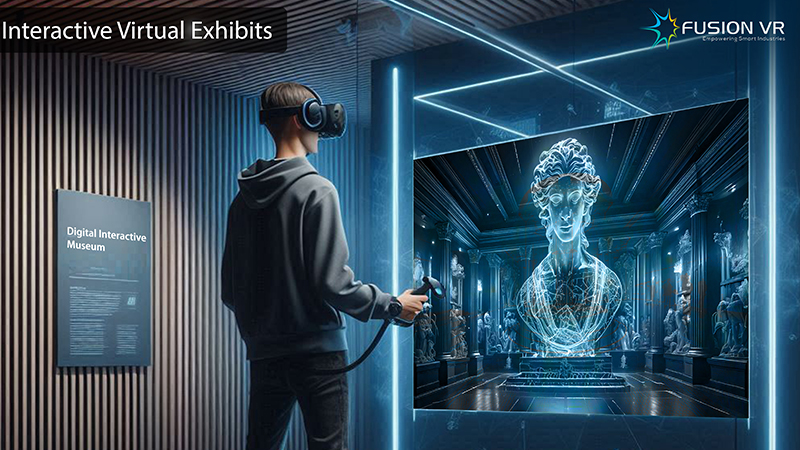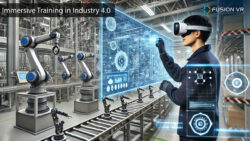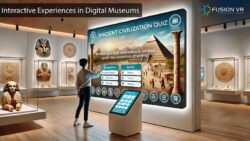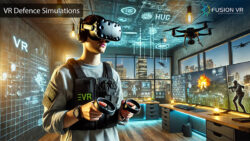Museums, which have long served as places where history meets culture and knowledge, enable visitors to transport themselves in narratives over centuries. In the new age of digitization, the incorporation of AR and VR in museums has changed how these institutions can interact with the audience. One of the most exciting new trends in this line is that of temporary virtual museums. These installations are digital replicas that work as mighty marketing tools for linking potential visitors with the physical museum space. By using AR VR museum experiences, interactive museums are now opened to a worldwide audience with amazing previews of what exists within their walls, thus boosting their visitor numbers.
The major benefit of temporary virtual museums is serving as a teaser for potential visitors. With digital experiences booming, audiences now expect more than just static images or brochures before making an actual decision on visiting a real-life museum. A virtual museum is a very active representation of the museum collection. Here, the user can move through digital replicas of the exhibits, allowing for an interactive experience. Such involvement in the museum experience provokes curiosity, increasing the likelihood of visiting the actual museum. For any museums or heritage sites that use VR – Virtual Reality or AR – Augmented Reality in their place, creating lifelike digital spaces would attract visitor interest before they enter the physical space.
Temporary virtual museums can market real museums- increasing one of the dimensions through accessibility. Physical museums require travel, time, and any financial resources to visit, all of which limit the access of many individuals. Now, augmented reality and virtual reality museum platforms can penetrate this barrier by showcasing live online exhibitions that provide a stimulating preview of the actual collection. With high-resolution 3D models, interactive storytelling, and even live guides in augmented reality, the experience is made more interesting for visitors. This piques the interest of people who’ve not visited because of distance or lack of time, making them more likely to visit in the future.
The last evolution to happen with marketing strategies for museums is to go digital. AR in museums today allows the institution to create shared-content which could extend the reach online using social media and digital ads. Temporary virtual museums, launched as part of the exhibition campaign, cause a buzz in conversations across platforms. Potential visitors engage with the content, sharing experiences and informing others, which can even amplify the brand of a museum. An AR VR museum concept is futuristic, making it appealing to the tech-savvy audience. Museums keep pace with the increasingly digital-first world.
A temporary museum can be set up with minimal technological equipment and gears at any place, for instance, a minimal set-up can be made within a mall, any public event space, a banquet hall or even in any small room. With the help of VR headsets, gears, 3d projectors, AR-integrated assets, and other gadgets, any small room can be transformed into an interactive temporary museum that transports the visitor to an all-new virtual world to experience the exhibits of a real museum. This experience creates interest and curiosity among the visitors to visit the real museum.
Temporary virtual museums actualize engaging places for interactive museums. However, online temporary virtual museums are critical because they are essential for creating a previsit bridge to sustain visitor interests. For museums with seasonal exhibitions and short-term showcases, virtual versions also offer seamless channels of continuity through which they market exhibitions. After an exhibition, a museum may retain an experience in the online space to allow possible visitors to browse past highlights. This furthers the museum’s identity as a changing space constantly offering new experiences. Curators can have augmented reality through which the visitors can view 360-degree explorations, AR overlays revealing hidden details, and virtual scavenger hunts encouraging intensive engagement.
All these educational dimensions must also become critical in temporary virtual museums. Because of that, many museums are knowledge-oriented. Learning is now facilitated over immense digital displays. These bring history, science, and art to life in an almost tactile experience touching the artifacts without the visit’s often unavailability of physical access. For example, those will conduct a virtual tour, within which a user zooms onto a manuscript from ancient times, a user watches a three-dimensional reconstruction of a historical site, or possibly even has some augmented reality animations that demonstrate the significance of an artifact. This makes the experience richer as it sunders modes of learning and makes museums equally pleasant experiences for students, educators, and lifelong learners.
Of course, a temporary virtual museum may serve as a flexible medium for connecting global audiences toward museums. Unlike traditional marketing via print material or localized campaigns, digital exhibitions are hidden from any geographical boundaries. There’s a museum in one part of the world, displaying its collection to audiences thousands of miles from it. Cultural exchange and important dialogue will follow. Augmented reality creates immersive experiences that can be perceived not just as visual but interactive, heightening an individual’s sense of presence, thus closing the gap between virtual and real encounters. Such capacity attracts international visitors and raises museum reach and revenue potential via online ticket sales, donations, and memberships.
Another main advantage being that of testing the exhibition formats without installing in physical spaces. Museums explore various ways and means to exhibit content. This includes trying out a temporary virtual museum as a testing ground for new ideas. They now monitor visitor interactions, engagement levels, and comments about their experience in the virtual museum. Based on this data, curators can design everything from what they will show to how the exhibition will look for the real-life setting. This limits the risk of failure associated with setting up large-scale physical spaces while improving the reach of the final exhibition. For all the institutions adapting on AR VR museum experiences, this iterative approach ensures that there will be benefits for physical ones from all other digital possible engagements.
Temporary virtual museums constitute an environment-friendly means of museum marketing. Traditional means of advertisements such as printed brochures and banners, and posters-drain the environment. Digital exhibitions diminish the need for carrying along physical promotional materials while offering a more entertaining alternative. With augmented reality adoption, museums contribute to the cause of sustainability by preventing resource waste in the course of effective outreach. Organizing temporary virtual exhibitions also negates some extravagant physical installations with logistical costs and carbon footprint savings.
Temporary online museums further maximize fundraising and sponsorship options. Virtual space allows for showing partnerships between museums and brands, cultural organizations, or educational institutions. Sponsors may be included in ARVR museum experiences, thereby creating a modern advertising opportunity that resonates with present engagement approaches. This digital presence thus also monetarily benefits the museum while enhancing the credibility and visibility of sponsors within the domains of culture and education.
The interactive museum in the retention of audiences is fundamental, and with virtual experiences keeping visitors engaged even after a single visit, it plays a significant role. Many museum lovers create a certain emotional bond toward the exhibits, whose experiences are digitally retrievable in temporary virtual museum exhibitions. Be it an enthusiast of art revisiting their favorite painting in augmented reality or a history buff exploring ancient ruins in 3D, these moments engage visitors well beyond the physical visit. Such sustained engagement nurtures allegiance and encourages repeat visits and a strengthened community.
Short virtual museums can also become efficient during crises. Whenever a physical museum is disrupted due to renovation, natural calamity, or global events, virtual exhibitions serve to maintain continuity. The pandemic has emphasized the importance of having digital alternatives, and indeed many museums have resorted to using AR VR museum solutions to have their collections still accessed by the public. Even after the pandemic, this strategy will remain useful as it allows museums to continue engaging with even different situations. Museums adopting AR in museums as part of their long-term strategy will continue to be resilient and adaptable in a world that keeps changing.
Thus, the fact remains that temporary virtual museums have great power in marketing for physical one. It is true that augmented reality in museums extends human reach, improves accessibility, and provides memorable previews that inspire actual visits. It turns into the presentation of interactive narratives online. The visitors to hectares can also be taken with it. Temporary virtual museums change the museum marketing game between temping and hyperbole, energizing audiences by stimulating conversation and trialling new ideas, all the while connecting with transnational communities. As technology continues to develop, museums that advocate virtual experiences in their battle will not only gain more interesting visitors but also change giving and receiving messages on the very definition of visiting a site by narrowing and blurring the lines of tradition and timeliness.





